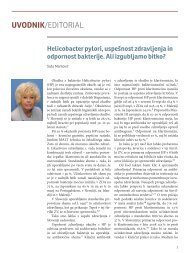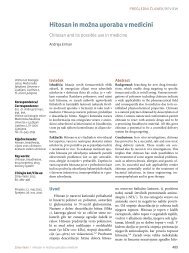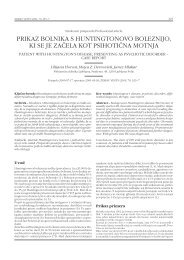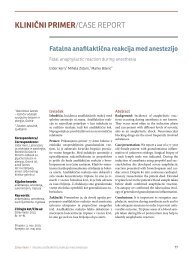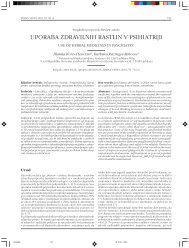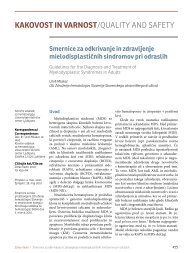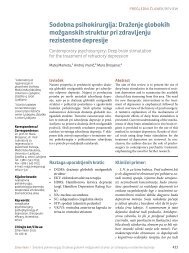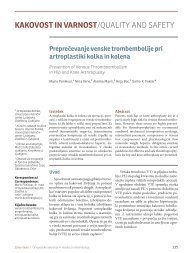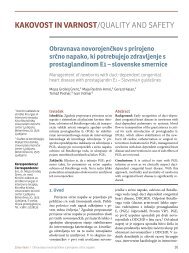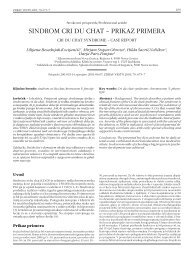Vpliv implantacije zarodkov na endometrij v lutealni fazi ciklusa
Vpliv implantacije zarodkov na endometrij v lutealni fazi ciklusa
Vpliv implantacije zarodkov na endometrij v lutealni fazi ciklusa
You also want an ePaper? Increase the reach of your titles
YUMPU automatically turns print PDFs into web optimized ePapers that Google loves.
Zdrav Vestn 2009; 78: I-101–3<br />
I-101<br />
Raziskovalni prispevek/Research article<br />
VPLIV IMPLANTACIJE ZARODKOV NA ENDOMETRIJ<br />
V LUTEALNI FAZI CIKLUSA<br />
INFLUENCE OF EMBRYO IMPLANTATION ON ENDOMETRIUM IN LUTEAL<br />
PHASE OF MENSTRUAL CYCLE<br />
Roma<strong>na</strong> Dmitrović, Veljko Vlaisavljević<br />
Oddelek za reproduktivno medicino, Klinika za ginekologijo in peri<strong>na</strong>tologijo, Univerzitetni klinični<br />
center Maribor, Ljubljanska 5, 2000 Maribor<br />
Izvleček<br />
Izhodišča<br />
Metode dela<br />
Rezultati<br />
Zaključki<br />
Na temelju z<strong>na</strong>nj s področja embriologije vemo, da je za lutealno fazo menstruacijskega<br />
<strong>ciklusa</strong> z<strong>na</strong>čil<strong>na</strong> hitra rast <strong>endometrij</strong>a. Namen <strong>na</strong>še raziskave je bil ugotoviti, ali je možno<br />
s transvagi<strong>na</strong>lnim ultrazvokom in hormonskimi testi ugotoviti normalno nosečnost,<br />
preden jo potrdimo ultrazvočno s prisotnostjo gestacijskega obročka. Osnov<strong>na</strong> hipoteza je<br />
bila, da je debeli<strong>na</strong> in/ali prostornino <strong>endometrij</strong>a v <strong>lutealni</strong> <strong>fazi</strong> menstruacijskega <strong>ciklusa</strong><br />
pri preiskovankah, ki zanosijo, bistveno drugač<strong>na</strong> kot pri preiskovankah, ki ne zanosijo.<br />
Poleg tega smo predpostavili, da se debeli<strong>na</strong> in/ali prostornine <strong>endometrij</strong>a razlikuje pri<br />
preiskovankah z normalno nosečnostjo v primerjavi s preiskovankami, pri katerih gre za<br />
nepravilno nosečnost (biokemič<strong>na</strong> nosečnost, zu<strong>na</strong>jmaternič<strong>na</strong> nosečnost in spontani<br />
splav). Poleg meritev prostornine <strong>endometrij</strong>a smo opravili tudi merjenje <strong>endometrij</strong>a v<br />
treh ravneh (debeli<strong>na</strong>, dolži<strong>na</strong> in širi<strong>na</strong>). Ugotavljali smo, ali je omenje<strong>na</strong> alter<strong>na</strong>tiv<strong>na</strong><br />
tehnika, ki je sicer uveljavlje<strong>na</strong> v svetu, dovolj dober približek za določanje prostornine<br />
<strong>endometrij</strong>a.<br />
Pri preiskovankah, vključenih v program zu<strong>na</strong>jtelesne oploditve, smo opravili prospektivno<br />
opazovalno raziskavo. Preiskovanke smo hormonsko spodbujali po standardnih protokolih<br />
spodbujanja rasti foliklov. Folikle smo aspirirali 36 ur po dajanju hCG, prenos <strong>zarodkov</strong><br />
pa čez 3 ali 5 dni. Preiskovanke smo <strong>na</strong>ročili <strong>na</strong> kontrolo dvakrat: prvič med 20. in 24.<br />
dnem menstruacijskega <strong>ciklusa</strong> (dmc), in drugič med 27. in 30. dmc. Ob obeh obiskih smo<br />
preiskovankam vzeli kri za določitev hormonov in s 3-D transvagi<strong>na</strong>lnim ultrazvokom<br />
izmerili <strong>endometrij</strong>. Po opravljenih obeh obiskih smo preiskovanke, ki so imele pozitiven<br />
beta hCG, v obdobju do 12. ted<strong>na</strong> nosečnosti poklicali po telefonu in jih povprašali o izidu<br />
nosečnosti.<br />
Osemdeset preiskovank je podpisalo privolitveno izjavo. Od teh smo pri 4 preiskovankah<br />
opravili intrauterino insemi<strong>na</strong>cijo (IUI) v spodbujenem ciklusu, 1 preiskovanka je imela<br />
prenos <strong>zarodkov</strong> v spontanem ciklusu, pri 74 preiskovankah pa smo opravili postopek<br />
zu<strong>na</strong>jtelesne oploditve v spodbujenem ciklusu. Od slednjih je 63 preiskovank sodelovalo<br />
do konca raziskave, zato smo jih vključili v statistično a<strong>na</strong>lizo. Od 63 preiskovank jih je 36<br />
(57,1 %) zanosilo, a 27 (42,8 %) ni zanosilo. Med temi je bila pri 9 (25 %) preiskovankah<br />
ugotovlje<strong>na</strong> nepravil<strong>na</strong> nosečnost, zato smo jih obrav<strong>na</strong>vali ločeno. Pri preiskovankah,<br />
ki so zanosile, so se prostorni<strong>na</strong> <strong>endometrij</strong>a ter debeli<strong>na</strong>, dolži<strong>na</strong> in širi<strong>na</strong> <strong>endometrij</strong>a,<br />
izmerjeni ob obisku 1 in ob obisku 2 statistično z<strong>na</strong>čilno razlikovali. Razlike v omenjenih<br />
parametrih med obiskoma 1 in 2 pri preiskovankah, ki niso zanosile, nismo mogli potrditi.<br />
Z<strong>na</strong>čilno razliko pa smo ugotovili pri primerjavi <strong>na</strong>vedenih parametrov ob obisku 2 med<br />
preiskovankami, ki so zanosile, in tistimi, ki niso zanosile.<br />
Naša raziskava je pokazala, da lahko pri preiskovankah, ki so zanosile v postopku zu<strong>na</strong>jtelesne<br />
oploditve, s 3-D ultrazvokom že nekaj dni po zanositvi zaz<strong>na</strong>mo hitro in močno<br />
povečanje prostornine <strong>endometrij</strong>a. Poleg tega smo pri preiskovankah, ki niso zanosile v<br />
tem ciklusu, opazili nez<strong>na</strong>tno do zmerno zmanjšanje prostornine <strong>endometrij</strong>a. Pokazali<br />
smo tudi, da lahko merjenje spremembe prostornine <strong>endometrij</strong>a z zadovoljivo <strong>na</strong>tančno-
I-102 Zdrav Vestn 2009; 78: SUPPL I<br />
stjo <strong>na</strong>domestimo z merjenjem debeline <strong>endometrij</strong>a ter njegove dolžine in širine, kar je<br />
možno opraviti <strong>na</strong> vsaki ultrazvočni <strong>na</strong>pravi. Kljub priporočljivim <strong>na</strong>daljnjim raziskavam<br />
menimo, da je mogoče <strong>na</strong>še ugotovitve koristno uporabiti v vsakodnevni klinični praksi,<br />
predvsem pri tehtanju, ali je nosečnost normal<strong>na</strong> ali ne, ter pri ugotavljanju nosečnosti v<br />
zgodnjem obdobju po morebitni zanositvi, še preden je mogoče potrditi prisotnost gestacijskega<br />
obročka.<br />
Ključne besede<br />
IVF; implantacija; <strong>endometrij</strong>; ultrazvok; 3D a<strong>na</strong>liza<br />
Abstract<br />
Background<br />
Methods<br />
Results<br />
Conclusions<br />
Key words<br />
Based on the facts known from embryology, rapid endometrial growth during late luteal<br />
phase of the cycle could be expected. In this research, we sought to establish if normal<br />
intrauterine preg<strong>na</strong>ncy could be confirmed before gestatio<strong>na</strong>l sac vizualization, by transvagi<strong>na</strong>l<br />
ultrasound and hormo<strong>na</strong>l tests. The primary hypothesis was that the endometrial<br />
thickness and/or volume in the luteal phase of the cycle, in cycles resulting in normal intrauterine<br />
preg<strong>na</strong>ncy, is significantly different compared to non-conception cycles. We also<br />
hypothesized that endometrial thickness and/or volume are different in cycles resulting<br />
in normal intrauterine preg<strong>na</strong>ncy compared to cycles resulting in abnormal preg<strong>na</strong>ncy,<br />
<strong>na</strong>mely biochemical and ectopic preg<strong>na</strong>ncy, and spontaneous abortion. Additio<strong>na</strong>lly, next<br />
to endometrial volumes, we decided to measure the endometrium in three planes (thickness,<br />
length and width), to see if the hypothesized endometrial volume differences could be<br />
approximated by this simple surrogate technique, which is available in most parts of the<br />
world.<br />
This was a prospective observatio<strong>na</strong>l study of women enrolled in an assisted reproduction<br />
program. Patients were stimulated with standard stimulation protocols. The oocyte retrieval<br />
was performed 36 hours after the hCG administration and the embryo was transferred 3 or<br />
5 days later. Patients were first seen on day 20–24 of the cycle , and then on day 27–30 of<br />
the cycle. A blood sample was taken, and 3D transvagi<strong>na</strong>l ultrasound was done. Following<br />
the completion of study visits, patients with a positive β HCG test received phone call checkups<br />
until week 12 of preg<strong>na</strong>ncy, and were stratified according to preg<strong>na</strong>ncy outcome.<br />
80 subjects signed the informed consent form. 4 patients had the IUI in the stimulated cycle,<br />
one had ET in spontaneous cycle, and 74 patients had undergone IVF/ET in the stimulated<br />
cycle. 63 patients in the stimulated cycles completed the study and are included in the statistical<br />
a<strong>na</strong>lysis presented here. Of these 63 patients, 36 (57.1 %) patients were preg<strong>na</strong>nt,<br />
and of these 36, nine (25 %) had abnormal preg<strong>na</strong>ncies that were a<strong>na</strong>lyzed separately. 27<br />
(42.8 %) patients were not preg<strong>na</strong>nt in the stimulated cycle. A significant difference was<br />
observed between Visit 1 and Visit 2, for endometrial volume, thickness, length and width in<br />
the preg<strong>na</strong>nt group, and for endometrial volume, thickness and width in the non-preg<strong>na</strong>nt<br />
group. Also, a significant difference was observed when comparing parameters at Visit 2<br />
between preg<strong>na</strong>nt and non-preg<strong>na</strong>nt patients.<br />
In this study we have shown that in normal intrauterine preg<strong>na</strong>ncy after an IVF/ET, a rapid<br />
and prominent endometrial volume growth can be detected by a 3D ultrasound over the<br />
course of several days. Moreover, in patients who did not conceive in a particular cycle, a<br />
minimal to moderate decrease in endometrial volume can be seen in all patients. We have<br />
also shown that the changes in endometrial volume can be approximated by measuring the<br />
changes in endometrial thickness, length and width, which can be done on every ultrasound<br />
machine. Although it warrants further investigation, we believe these findings may prove<br />
useful in everyday practice and when there is uncertainty as to whether the preg<strong>na</strong>ncy is<br />
normal or abnormal, and before gestatio<strong>na</strong>l sac visualization.<br />
IVF; implantation; endometrium; ultrasound; 3D<br />
Literatura<br />
1. Alcazar JL. Three-dimensio<strong>na</strong>l ultrasound assessment of endometrial receptivity: a review. Reprod Biol Endocrinol 2006; 4: 56.<br />
2. Bassil S. Changes in endometrial thickness, width, length and pattern in predicting preg<strong>na</strong>ncy outcome during ovarian stimulation in<br />
in vitro fertilization. Ultrasound in Obstetrics and Gynecology 2001; 18: 258–63.
Dmitrović R, Vlaisavljević V. <strong>Vpliv</strong> <strong>implantacije</strong> <strong>zarodkov</strong> <strong>na</strong> <strong>endometrij</strong> v <strong>lutealni</strong> <strong>fazi</strong> <strong>ciklusa</strong><br />
I-103<br />
3. Martins WD, Ferriani, RA, Nastri CO, Maria Dos Reis R, Filho FM. Measurement of endometrial volume increase during the first week<br />
after embryo transfer by three-dimensio<strong>na</strong>l ultrasound to detect preg<strong>na</strong>ncy: a prelimi<strong>na</strong>ry study. Fertil Steril 2007;<br />
4. Vlaisavljevic V., Reljic M, Gavric-Lovrec V, Kovacic B. Subendometrial contractility is not predictive for in vitro fertilization (IVF) outcome.<br />
Ultrasound in Obstetrics and Gynecology 2001; 17(3): 239–44.<br />
5. Zohav, E, Orvieto R, Anteby EY, Segal O, Meltcer S, Tur-Kaspa I. Low endometrial volume may predict early preg<strong>na</strong>ncy loss in women<br />
undergoing in vitro fertilization. Jour<strong>na</strong>l of assisted reproduction and genetics 2007; 24: 259–61.<br />
Prispelo 2009-09-03, sprejeto 2009-10-01



